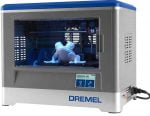Choosing a 3D Printer
Choosing a 3D Printer

Choosing a 3D Printer
Once you start choosing a 3D printer, it’s always important to decide how and for what purpose it is going to be used. Maybe you were expecting a long list of printers sorted from the best to the worst – but that’s pretty much impossible to do without oversimplifying things to extremes. Instead, we would like to present you with a set of questions you should ask yourself before buying a 3D printer. Answering these will help you select the right machine for your purposes.
What price range are you aiming for? Expensive professional printers or cheap Chinese products?
The price reflects the quality of the build and the lifespan of the printer along with other “nice-to-have” features.
What is the customer support for the printer? Is there an active community, which could potentially help me in case I run into trouble? Is the printer open-source? What about spare parts and upgrades?
This is probably the most important question. Communities are becoming one of the most important factors when buying (not only) a 3D printer. The situation is similar with e.g. smartphones – manufacturers supports their models with new updates only for a limited time, however, if there’s an active community, the members can work on their own updates and extend the lifespan of the device. The same applies to 3D printers – open-source-based projects are ideal for active communities.
What are the running costs?
Certain manufacturers only allow use of their own branded materials and spare parts. This increases the running costs and also limits the range of supported materials.
How large printing surface do you really need?
It may look like it’s better to have a huge printing surface, however, in most cases it’s just a huge money waster. Objects made from PLA can’t be usually larger than 20 cm in one axis, due to thermal expansion, which causes larger objects to warp and detach from the print surface. Don’t forget that you can always cut the model into multiple pieces and glue them together.
How detailed prints do you need?
The quality and the level of detail of objects printed on an FFF printer can be affected by using a nozzle with a different diameter and by selecting the right materials, speed and temperatures. Although, it’s true that the level of detail on FFF printers is lower than on SLA printers.
You should decide for yourself, what are the best options for you, personally. Many of them are direct opposites, which means some compromises will be needed. In layman’s terms: if you are ok with a smaller printing area and you need high-quality prints, SLA is the way to go. However, most users will be perfectly happy with an FFF 3D printer.